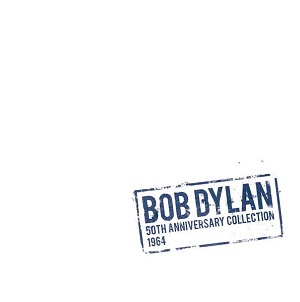A single visit to the studio in June was the source for Another Side Of Bob Dylan, and two sides’ worth of outtakes from it form the centerpiece of this set. Two incomplete, forced takes of “Black Crow Blues”, both on the guitar, demonstrate why the one on the album has piano. A 44-second excerpt of “Mr. Tambourine Man” seems to be included just because it can be, but four separate takes of “I Shall Be Free No. 10”, some with different words, show both how and why it was edited on the LP.
A tape recorded with Eric Von Schmidt (the blues guitar player he’d met in the green pastures of Harvard University) spans three sides and follows the pair running through blues riffs, R&B covers, silly impromptu songs and what appears to be the first recorded performance of “Tambourine Man”. If you’d rather hear him spar vocally with Joan Baez, four tinny “duets” are placed where they belong.
The rest of the material chronicles various live performances, beginning with a short set from Canadian television that closes with a nice version of “Restless Farewell”. Two of the records cover a London performance two years to the day before the notorious “Albert Hall” concert, recorded in excellent quality. “Walls Of Red Wing” and “Eternal Circle” are the rarities here, along with another “Restless Farewell”. The concerts on either side of the Halloween Philharmonic Hall show are, unfortunately, barely listenable; the intercom-quality sound in Philadelphia obscures the crowd’s laughter at “I Don’t Believe You” and their wonder at “It’s Alright Ma”, and renders the variations in “Talkin’ World War III Blues” inaudible. The California shows are a bit clearer but marred by the taper’s conversations. These would never have passed for official releases, so having them here to “protect” their copyright is laughable.
Somewhere out there somebody spent lots of money on one of the thousand copies of this set, and generously shared it over the Internet. Some people will buy anything.
Bob Dylan 50th Anniversary Collection 1964 (2014)—2½
CD availability: none; LP only

The main purpose of the Copyright Collections is to keep labels who deal in unauthorized releases of out-of-copyright recordings from releasing the music legally in Europe. Dylan's people/Columbia/Sony do not want their official releases to have to compete in regular European stores (brick & mortar and online) with unauthorized stuff. It's simply a question of keeping shelf space (brick & mortar stores) and search results (online stores) free of unauthorized stuff.
ReplyDeleteIn Europe recorded music falls out of copyright 50 years after it was recorded, if it remains unreleased. The new copyright laws (in effect since 2013) offer 70 years of protection from the point of release. But the release must come within the 50 year timeframe after the recording was made.
Recordings which were recorded/released before 1963 are out of copyright in Europe, not matter what. [When Sony did the 1962 Copyright Collection in 2012 (which in the end turned out to be superfluous, legally) the new copyright laws were in the process of being implemented in all of the EU member states, the legal situation was unclear, so Sony simply went ahead with the release, just in case.] Therefore European record stores (and online stores) currently offer all those unauthorized releases of Dylan's first album (which was recorded in 1961 and released in 1962). There is nothing Dylan's people can do about that. But they sure want to keep unauthorized releases of later stuff out of the stores, hence the 1963 and 1964 Copyright Collections.
The small print run of those sets ensures that the records will end up in the hands of collectors, who know what they are buying. The bad quality audience tape of the Philadelphia 1964 show for example has been well-known among collectors for many, many years. Collectors have long cherished the tape because the remarkable thing about it is not the bad sound quality but the fact that it exists at all and that a fan managed to tape an entire show as early as 1964.